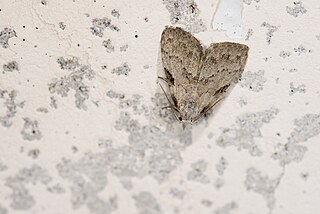
Chamaita is a genus of moths in the subfamily Arctiinae. The genus was erected by Francis Walker in 1862. Species are distributed throughout India, Sri Lanka, and Borneo.

Machairophora is a genus of moths in the subfamily Arctiinae first described by George Hampson in 1893. Two species are included, which are found from Sri Lanka and Papua New Guinea only.

Nudaria is a genus of moths in the subfamily Arctiinae erected by Adrian Hardy Haworth in 1809.

Manoba is a genus of moths in the family Nolidae. The genus was first described by Francis Walker in 1863.
Anachrostis is a genus of moths of the family Erebidae.

Arsacia is a monotypic moth genus of the family Noctuidae. Its only species is Arsacia rectalis. Both the genus and species were described by Francis Walker, the genus in 1866 and the species in 1863. It is found from the Indo-Australian tropics of India, Sri Lanka to Queensland and the Solomon Islands.
Chrysopera is a monotypic moth genus of the family Noctuidae erected by George Hampson in 1894. Its single species, Chrysopera combinans, was first described by Francis Walker in 1857. It is found from in the Indo-Australian tropics of India, Sri Lanka, Nepal, China east to New Guinea, Queensland, the Solomon Islands and Fiji.

Yepcalphis is a monotypic moth genus of the family Noctuidae erected by Nye in 1975. Its only species, Yepcalphis dilectissima, was first described by Francis Walker in 1858. It is found in Sri Lanka, the Oriental tropics, the Philippines, Sulawesi and the Sula Islands.

Delgamma is a monotypic moth genus of the family Noctuidae erected by Frederic Moore in 1885. Its only species, Delgamma pangonia, the strawberry cutworm, was first described by Achille Guenée in 1852.

Episteme is a genus of moths of the family Noctuidae. The genus was erected by Jacob Hübner in 1820. Species are widespread.
Holocryptis is a genus of moths of the family Noctuidae erected by Thomas Pennington Lucas in 1893.

Homodes is a genus of moths of the family Erebidae first described by Achille Guenée in 1852.
Hypenagonia is a genus of moths of the family Erebidae first described by George Hampson in 1893. The adult moths have pale brown wings with a dark band across each wing. The wingspan of these moths is about 1 centimeter.

Mimeusemia is a genus of moths of the family Noctuidae first described by Arthur Gardiner Butler in 1875. Species are found in Japan, India, Sri Lanka and Myanmar.
Nolasena is a monotypic moth genus of the family Erebidae. Its only species, Nolasena ferrifervens, is found in India, Sri Lanka, Borneo and the Philippines. Both the genus and species were first described by Francis Walker in 1858.
Oxygonitis is a monotypic moth genus of the family Noctuidae. Its single species, Oxygonitis sericeata, is found in the Indian subregion, Myanmar, Sumatra, Peninsular Malaysia, Java, Borneo, the Philippines, Sulawesi, Australia and Sri Lanka. Both the genus and species were first described by George Hampson in 1893.
Rhangena is a monotypic moth genus of the family Erebidae. Its only species, Rhangena roseipennis, is found in India and Sri Lanka. Both the genus and the species were first described by Frederic Moore in 1886.
Stenhypena is a genus of moths of the family Erebidae erected by George Hampson in 1895. The type species was first found in Sri Lanka.
Toxophleps is a genus of moths of the family Noctuidae erected by George Hampson in 1893. The species are transferred in to Tarache. The Global Lepidoptera Names Index and Lepidoptera and Some Other Life Forms describe this genus as a synonym of Cophanta.
Brana is a monotypic moth genus of the family Noctuidae. Its only species, Brana calopasa, is found in Sri Lanka and Australia. Both the genus and species were described by Francis Walker, the genus in 1858 and the species in 1859. It It is a serious pest on Berrya cordifolia.









